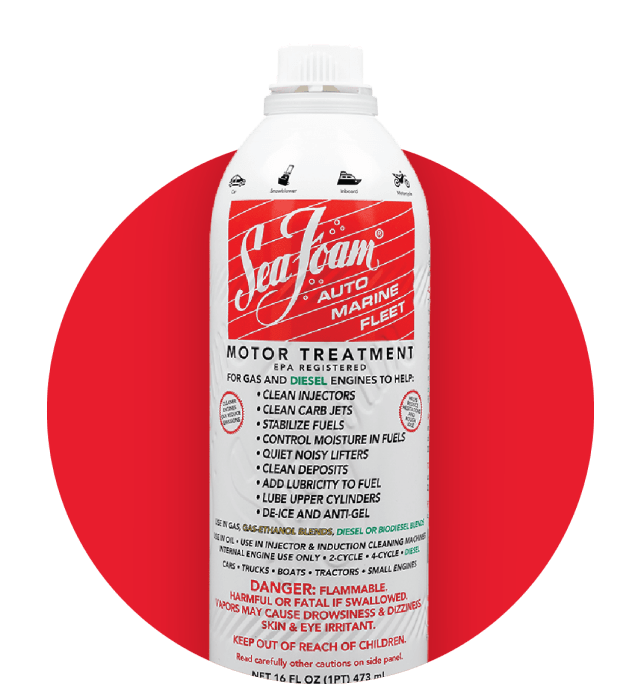HOW TO USE SEA FOAM MOTOR TREATMENT IN FUEL
BENEFITS
applicationS
treatment recommendations
SUMMARY
Pour Sea Foam in your fuel tank to clean and lubricate your entire fuel system. It works through fuel injectors and carburetors to remove harmful residues and deposits from fuel passageways, intake valves, pistons, and chamber areas.
For cleaning a gasoline or diesel fuel system, it’s safe to add more Sea Foam to fuel. In fact, the more Sea Foam you add to fuel, the better it cleans!
Made from petroleum ingredients, Sea Foam is safe and effective when used in all types of gasoline or diesel fuels and fuel blends. Sea Foam does NOT contain harsh detergent or abrasive chemicals that can harm your engine or fuel system components.

HOW TO USE a high concentration of SEA FOAM
mOTOR TREATMENT IN FUEL
RELATED QUESTIONS
Can I add Sea Foam with other fuel additives at the same time?
Hi Clarence,
Thanks for the question! Yes, you can mix Sea Foam with other fuel additives without worry. Just follow the directions on the can.
How much and when should I add Sea Foam to my oil and my fuel for my Scion XB 2012?
Thanks for the question, Corrie. Here’s how much and when to add Sea Foam in your 2012 Scion XB:
- Sea Foam Motor Treatment in fuel. I like to wait until the tank is low (1/4 -1/8 tank), add the whole 16 oz can, and then drive for at least 10-20 miles before refueling. It’s safe to add a high concentration like that and it works very well for cleaning fuel residues and deposits. Add it to fuel like this every 3,000 miles or once a year.
- Sea Foam Motor Treatment in oil. Add 1 ounce of Sea Foam per quart of oil in the crankcase. We recommend adding it 100-300 miles before your next oil change. That gives the Sea Foam enough time to circulate and clean, and it allows all the reliquefied oil residues to be drained away with the old oil. To help progressively clean up your oil crankcase, add it before every oil change.
You could also try High Mileage Motor Treatment. It’s made specifically for stubborn residues and deposits in higher-mileage vehicles. It’s a great cleaner!
Can I start using Sea Foam in my Honda Pilot 2025 which has only 17,000 miles without any negative effects?
Hi Aswad,
Thanks for the question!
Yes, you can start using Sea Foam in your 2025 Pilot. Sea Foam in the gas tank will help clean fuel residues and deposits and help keep your Honda running clean and strong.
I’d add it once a year or every 3,000 miles. I like to wait until the tank is low (1/4 -1/8 tank), add the whole 16 oz can, and then drive for at least 10-20 miles before refueling. It’s safe to add a high concentration like that and it works very well for cleaning fuel residues and deposits.
Adding that to your regular maintenance schedule will help your Pilot stay ahead of problems.
How much Sea Foam can I place directly into a chainsaw or a weedeater?
Thanks for the question!
You can safely use Sea Foam in both a chainsaw and a weedeater. The amount you add depends on what you’re trying to achieve:
For regular use / preventative maintenance: Add 2 ounces of Sea Foam per gallon of fuel. This will prevent gum and varnish from forming as well as prevent the fuel from degrading.
For a strong cleaning (if it’s running rough or hasn’t been cleaned before): Create a high cleaning concentration with something like the following ratio:
- 8 oz of Sea Foam in 16–32 oz of fuel (up to a 1:2 ratio of Sea Foam to gas)
Run the engine for a few minutes to pull the treated fuel into the carburetor, then let it sit and soak overnight. After that, run it as normal. The high concentration works very well to clean varnish and residue from small engine fuel systems.
It’s safe to use a lot of Sea Foam in small equipment like that and it works well to clean.
How many ounces of Sea Foam to a 23 gal gas tank?
Thanks for the question!
For preventative maintenance in a clean engine, our general recommendation is 1 ounce of Sea Foam per gallon of fuel, so for a 23 gallon tank that would be about 23 ounces if the tank is full.
For cleaning, I’d recommend adding more Sea Foam per gallon. Here’s what I’d do to get the most cleaning power:
-
Wait until the tank is low (about 1/4–1/8 tank).
-
Add a full 16 oz can of Sea Foam.
-
Drive 10–20 miles (or as normal) before refueling.
The idea here is to create a high cleaning concentration, which works better and faster than adding a small amount to a full tank. It’s safe to do and very effective at cleaning fuel residues and deposits.
Hope that helps and let me know if you have any other questions!
Best,
Conner
Sea Foam

Jim D.TECH
0